To celebrate the 10th Anniversary of the Wild Bird Club of the Philippines, Club Secretary Maia Tañedo compiled this list of the 10 Most Common Urban Birds in the Philippines
space
10 Most Common Urban Birds
by Maia Tañedo
Did you know that you can see at least 10 different kinds of birds in the city? To non-birdwatchers, the idea of seeing ten different bird species in the middle of a busy concrete jungle is quite hard to imagine but you’d be surprised to know that they are there, usually going unnoticed.
Here is a list of the top ten birds that can be seen in the city (plus some fun facts too!) Read on and discover how many you’ve actually seen and have in your neighborhood.
1. EURASIAN TREE SPARROW Passer montanus
Of course, the bird that would quite obviously make it to the top 1 spot is the Eurasian Tree Sparrow, more commonly known as the maya. This little brown bird can be seen everywhere in the city: from your backyard, to the sidewalks, to the busy business centers, and almost everywhere else in the city! That is why most people assume every bird that flies past is a maya.
The Eurasian Tree Sparrow or ETS is a species which was (very) successfully introduced in the Philippines. It usually forages on the ground and in trees and its diet consists mainly of seeds and grains, but has adapted to whatever available food in urban areas (foraging in garbage, etc.)
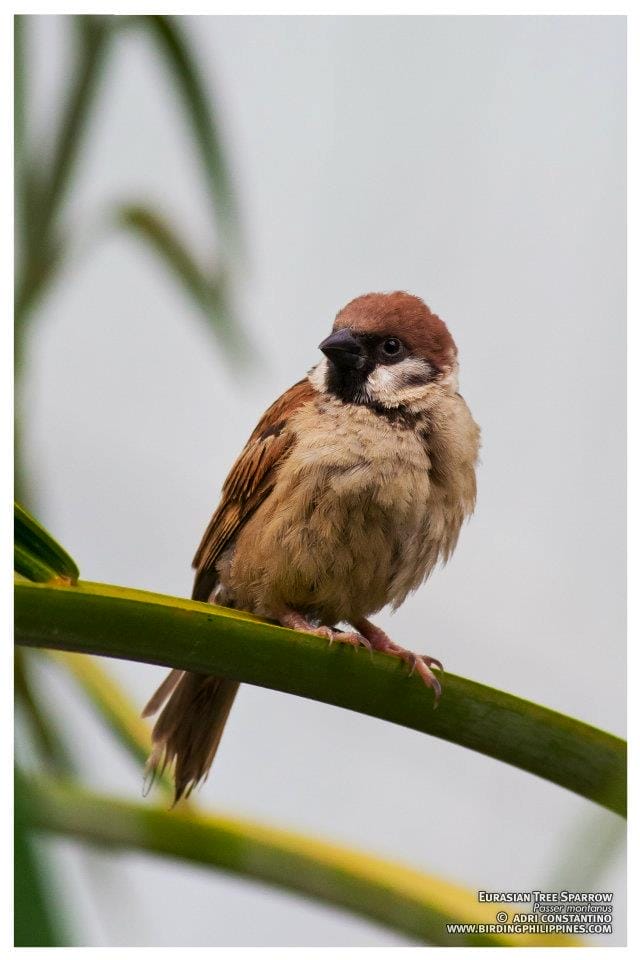
Fun Fact: Did you know that this maya bird was not the former Philippine National Bird? Yes, the Eurasian Tree Sparrow is called maya but in the Philippines, local names are used for a number of similar species. The former national bird was the Chestnut Munia, which is also locally called “mayang pula.”
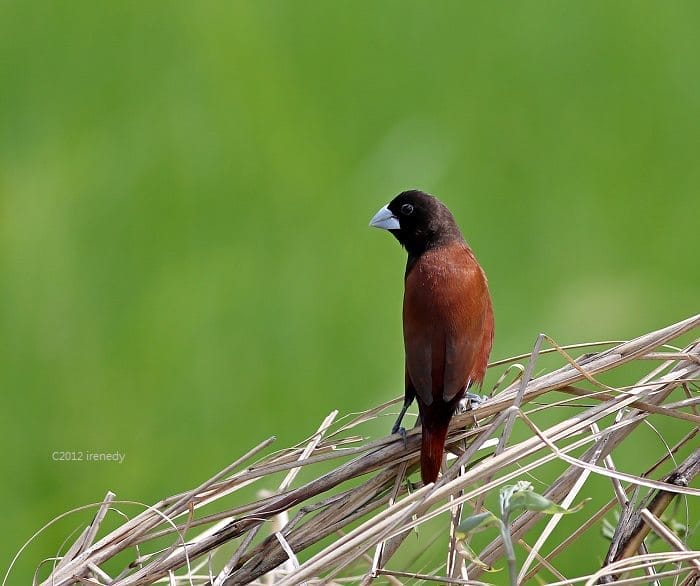
2. YELLOW-VENTED BULBUL Pycnonotus goiavier
The second most common, and most overlooked, city bird is the Yellow-vented Bulbul or YVB. With most people assuming that all birds in the city are mayas, the YVB goes unnoticed despite its larger size. It is significantly larger than the maya and has very distinct markings: white eyebrow, black eye stripe, a long tail and a flash of yellow on its vent (lower belly, just before the tail) for which it got its name. Some birds even sport a noticeable mohawk. The YVB actively feeds on berries and fruits and can also nest in urban gardens.
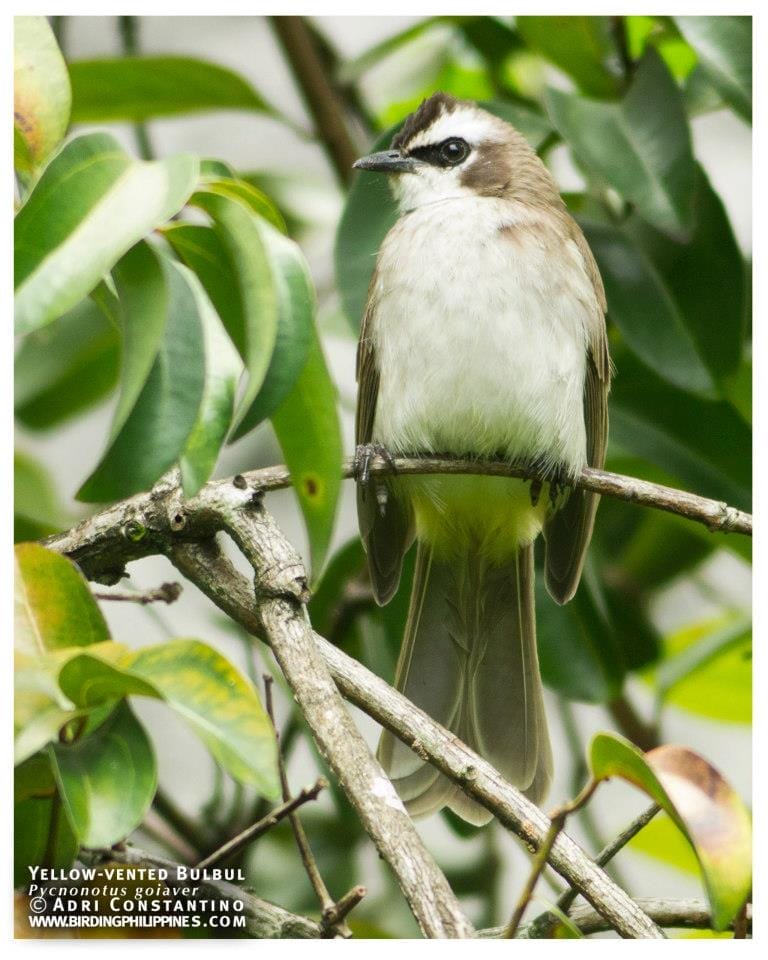
Fun Fact: The term “bulbul” is actually derived from the Persian word “bolbol” which means “nightingale.” These birds, which we only just read about in books, are actually all around us and have an assortment of bird calls. They have been observed in many a birdwatcher’s garden, nesting in low shrubs and also feeding on ripe finger chili and berries.
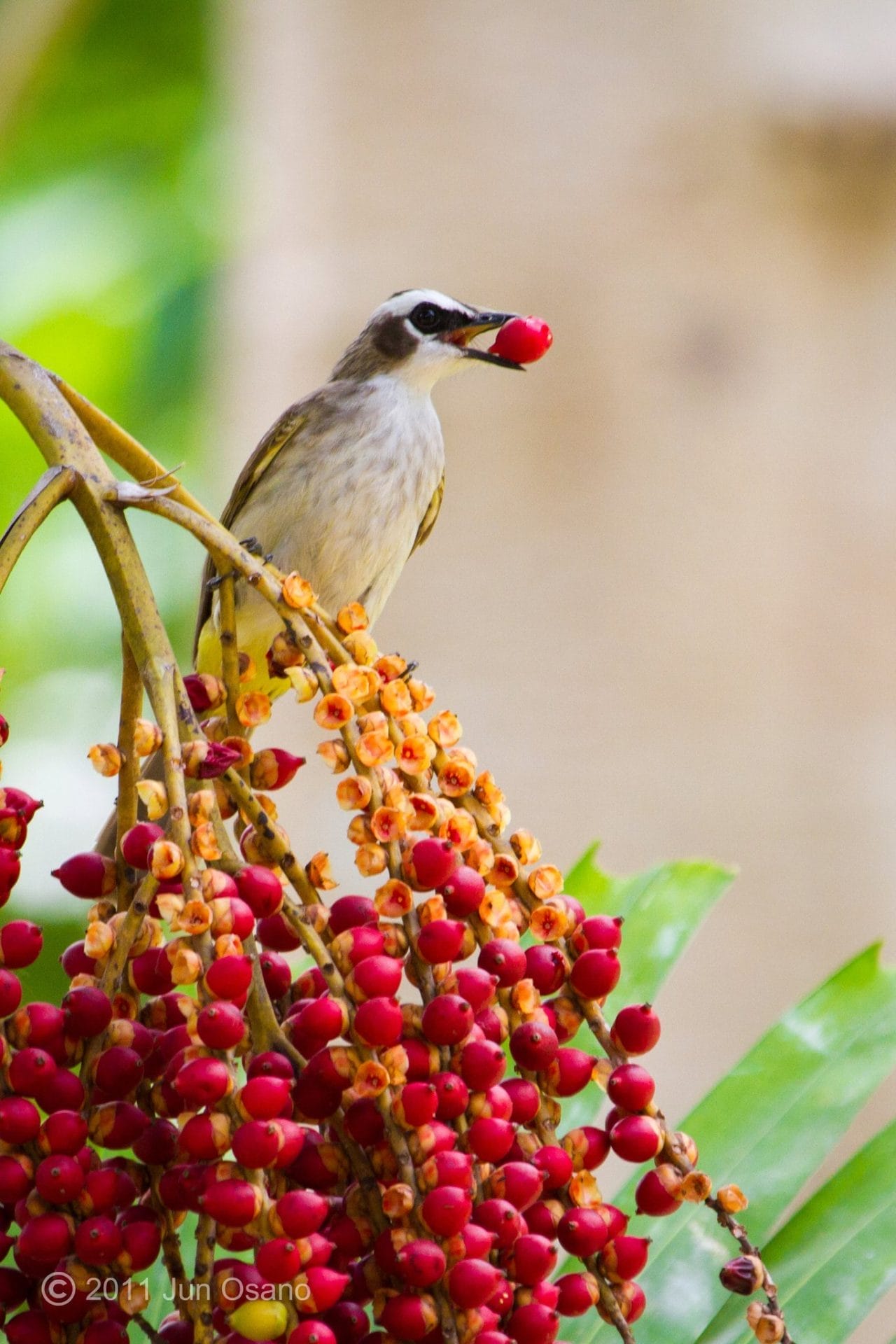
3. PIED FANTAIL Rhipidura javanica
The Pied Fantail, locally called Maria Capra, is another common city bird. It is black and white, with a very distinct long tail which it fans out thus its name. The Pied Fantail can be heard singing melodiously in the early hours of the morning. These birds can be very territorial especially if they have a nest nearby. They get people’s attention when they swoop around, “attacking” dogs, cats, and sometimes even people who get too close to their nest.

Fun Fact: “Pied” means “black and white” in birding language. Another “pied” bird that finds its way in green urban areas is the Pied Triller (which unfortunately did not make it to the top 10.)

4. OLIVE-BACKED SUNBIRD Nectarinia jugularis
We have been used to reading about beautiful, long-beaked hummingbirds in the US and guess what, the Philippines has its own family of similar birds – sunbirds! The most common species which can be found in urban gardens is the Olive-backed Sunbird. This small skittish bird has a very distinct long, thin beak which it uses to sip nectar from flowers. It’s back is a uniform olive color while its body is yellow. The male Olive-backed Sunbird has a beautiful metallic purple throat which differentiates it from the female. They can be seen fluttering around flowering plants such as heliconias and gumamelas, calling “swit-swit-swit.”
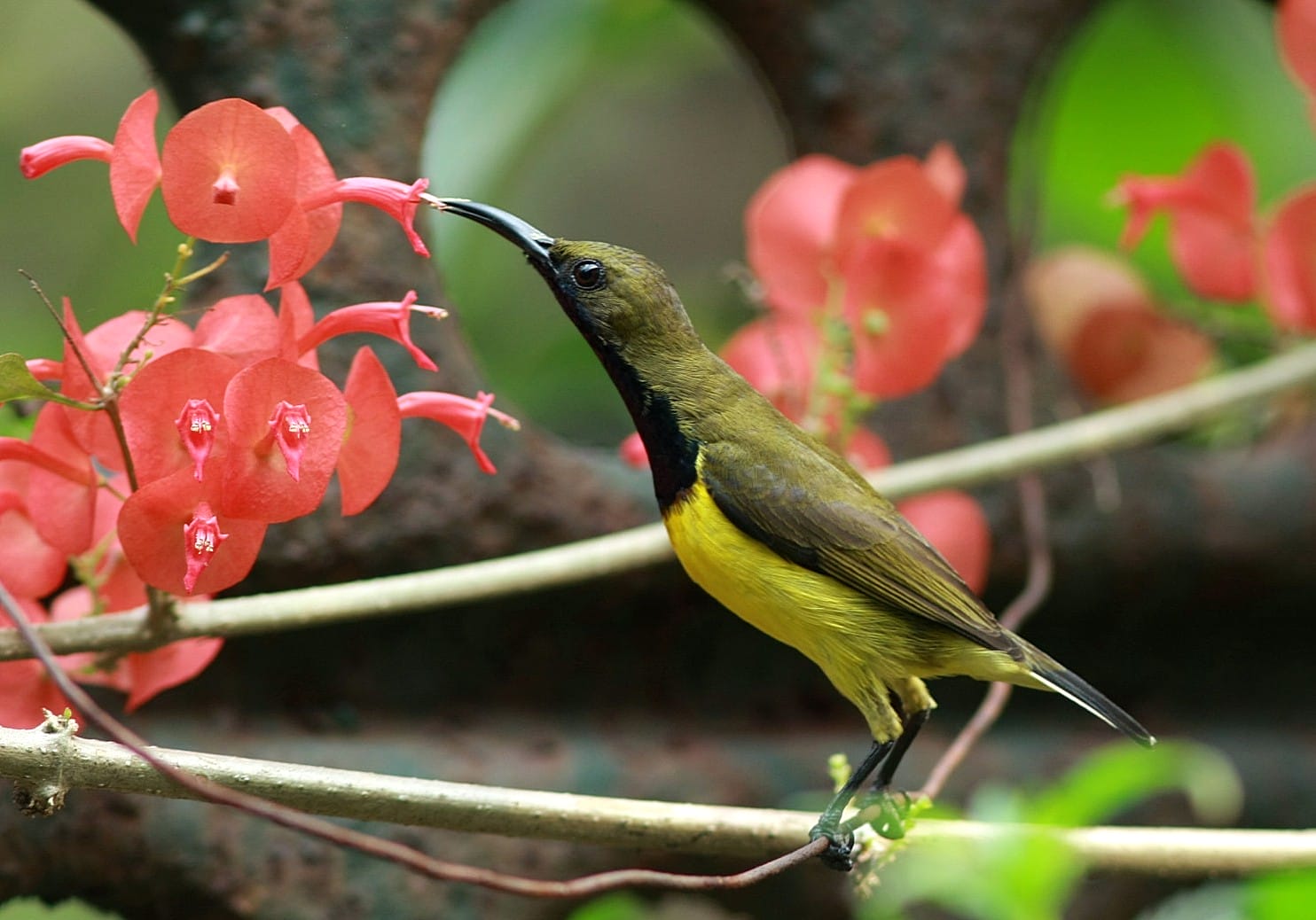
Fun Fact: Some birds have different markings for the male and female. The female Olive-backed Sunbird, though the same overall shape, size, and coloring as the male, lacks the metallic purple throat. It is uniformly yellow on its throat and belly.
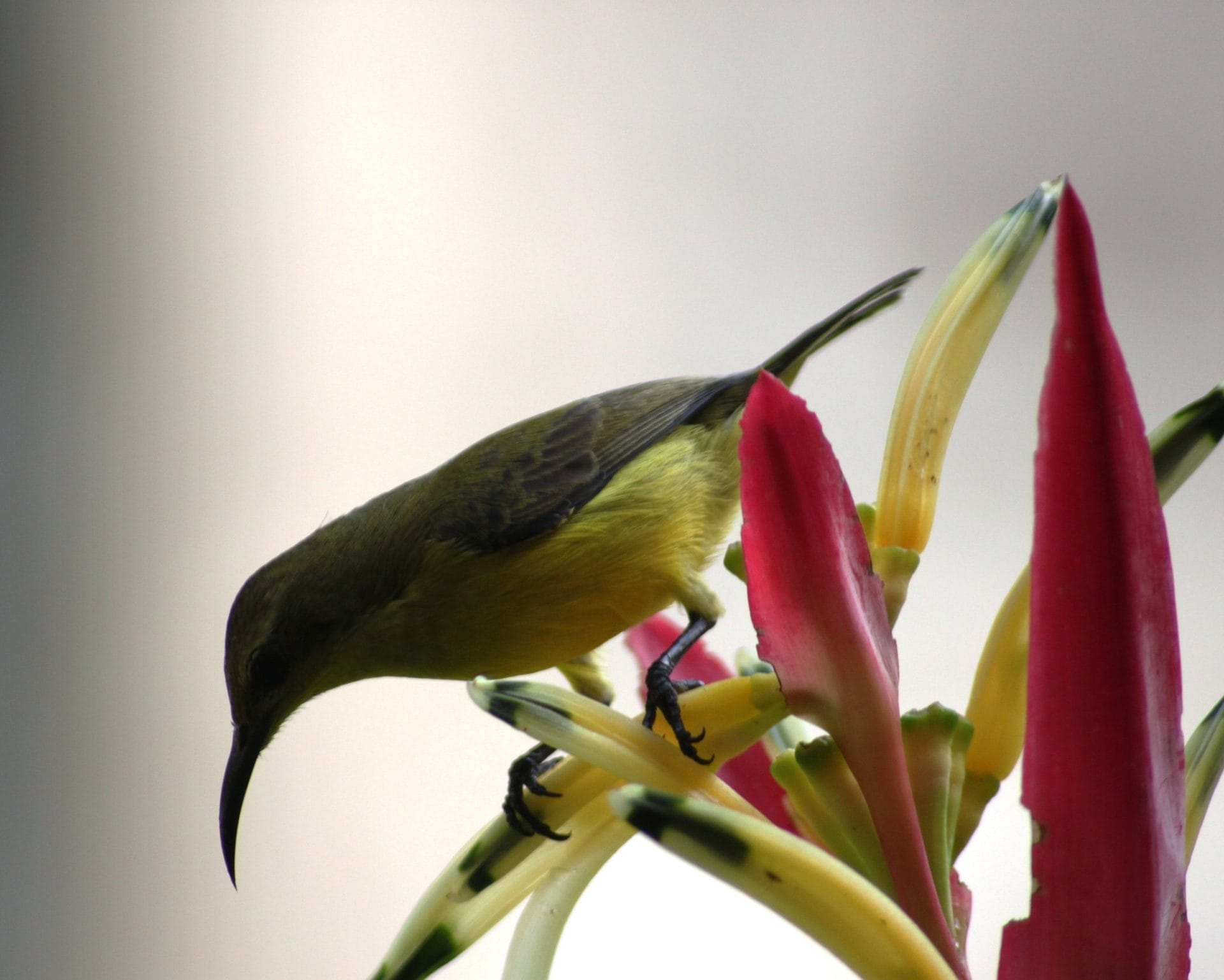
5. ZEBRA DOVE Geopelia striata
The Zebra Dove is another common city bird, usually seen foraging on the streets and sidewalks in our neighborhood. It is a grey bird with thin barrings (horizontal lines) on its upper parts. If you look closely enough, you will also see pinkish coloring on its chest and a bluish face. The local name of this bird is “bato-bato” which describes how the Zebra Dove can stay perfectly still and look like a “bato” or rock on the road. It also goes by other local names which are based on the sounds it makes: tukmo and kurokutok.
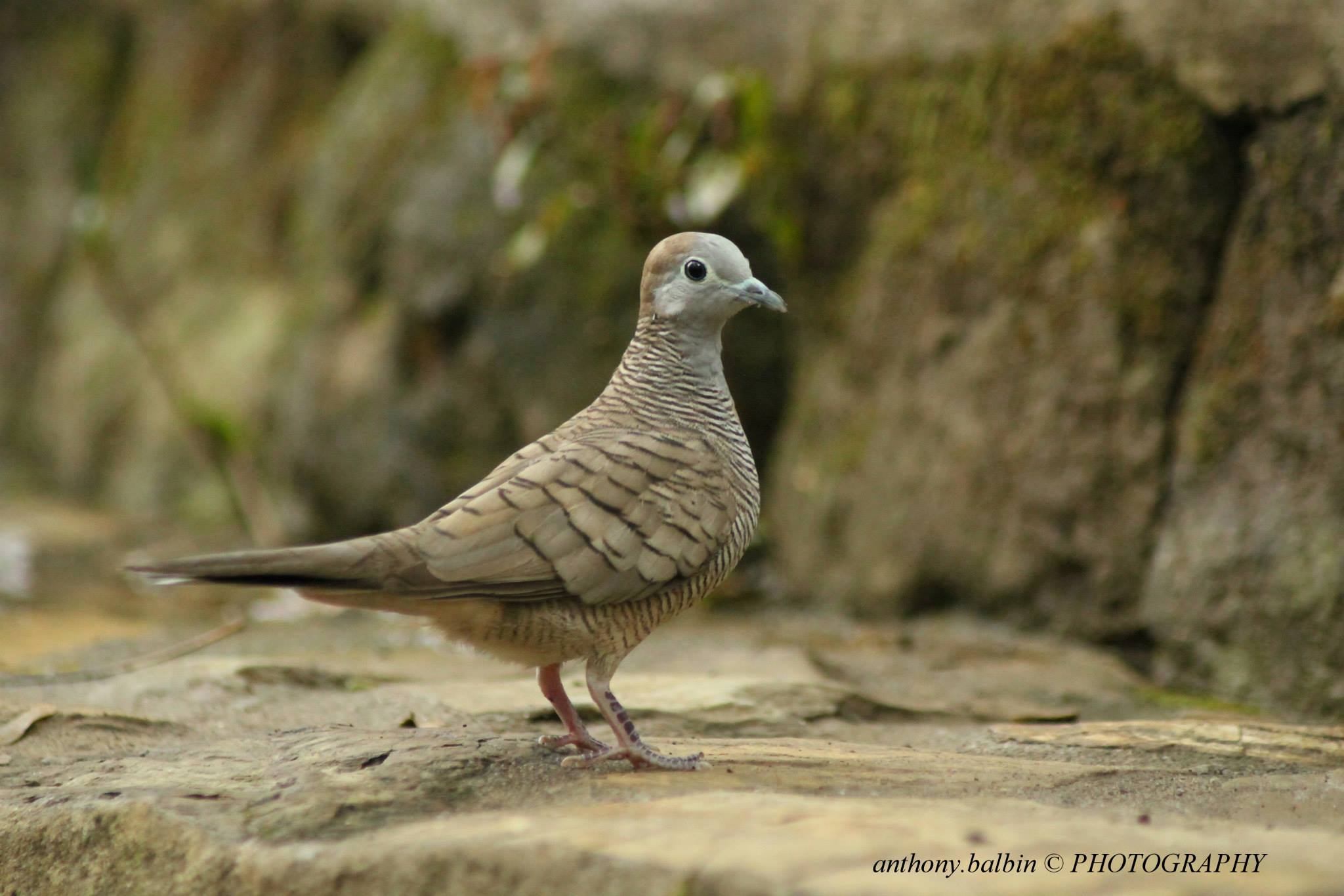
Bird Call: Here is a link to the call of the Zebra Dove. Listen and check if you’ve been hearing it in your neighborhood and discover why it is locally called “kurokutok.”
6. BLACK-NAPED ORIOLE Oriolus chinensis
One of the more colorful city birds, the Black-naped Oriole usually escapes a non-birders eye. But even birdwatchers may have difficulty spotting this yellow and black bird, as it blends very well with the green leaves on tall trees it likes to perch on. It is a medium-sized bird with a strong pink beak and a black mask around its eyes. Quite active and noisy birds, Black-naped Orioles can be seen calling loudly from tree tops, sometimes chasing each other through the trees.
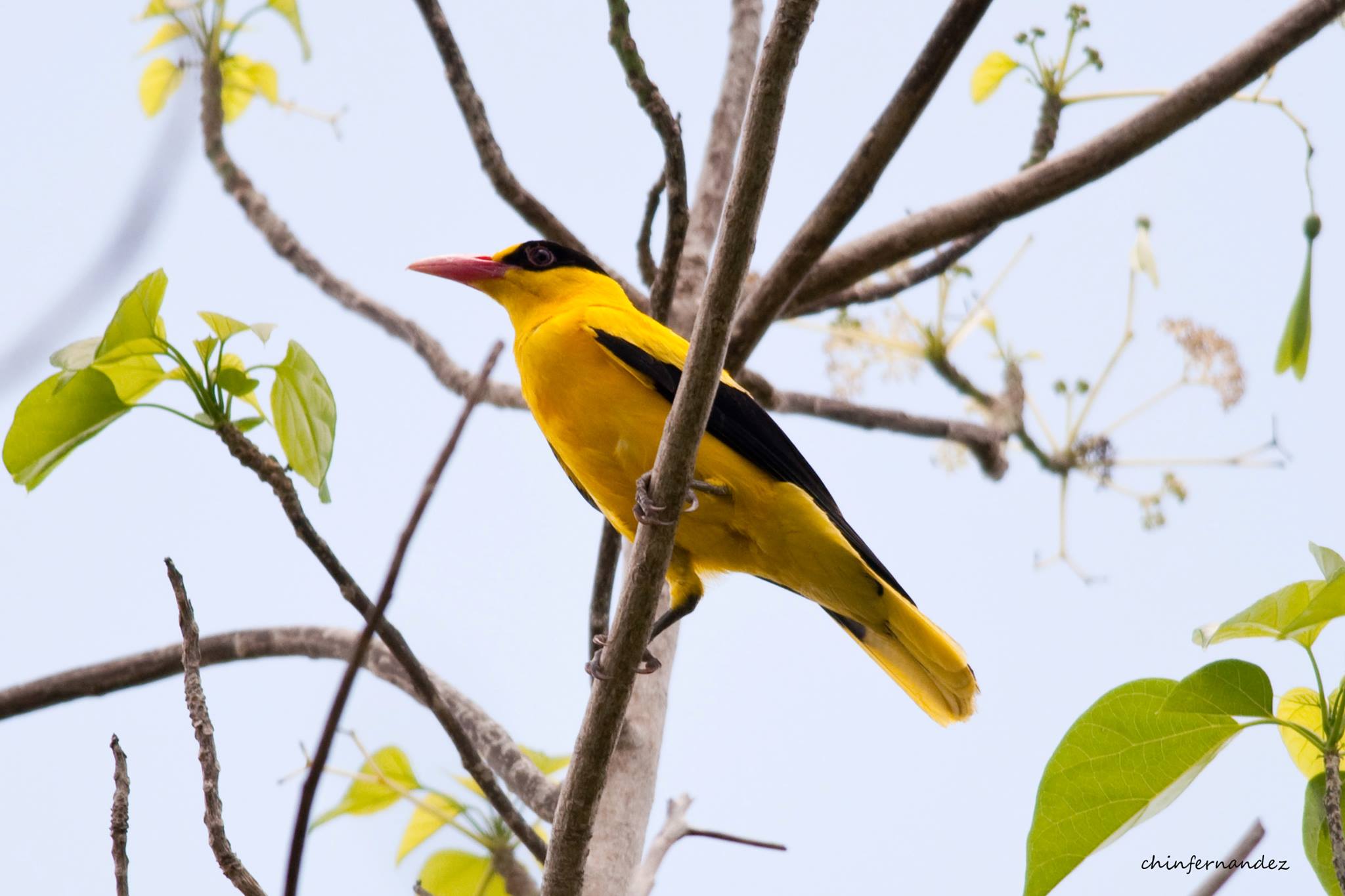
Fun Fact: The Black-naped Oriole is locally called kilyawan, based on the loud calls it makes. Click here to watch a very amusing video of a Black-naped Oriole calling just outside WBCP member Alice’s window!
7. GOLDEN-BELLIED FLYEATER Gerygone sulphurea
Have you ever noticed a melodious song of an unseen bird, most probably coming from a mango tree in your garden? That is the song of the Golden-bellied Flyeater. Usually more often heard than seen, it is another bird that lives in the city. The Golden-bellied Flyeater has uniformly olive brown back and pale yellow underparts. It is usually very skittish, hopping from one branch to another.
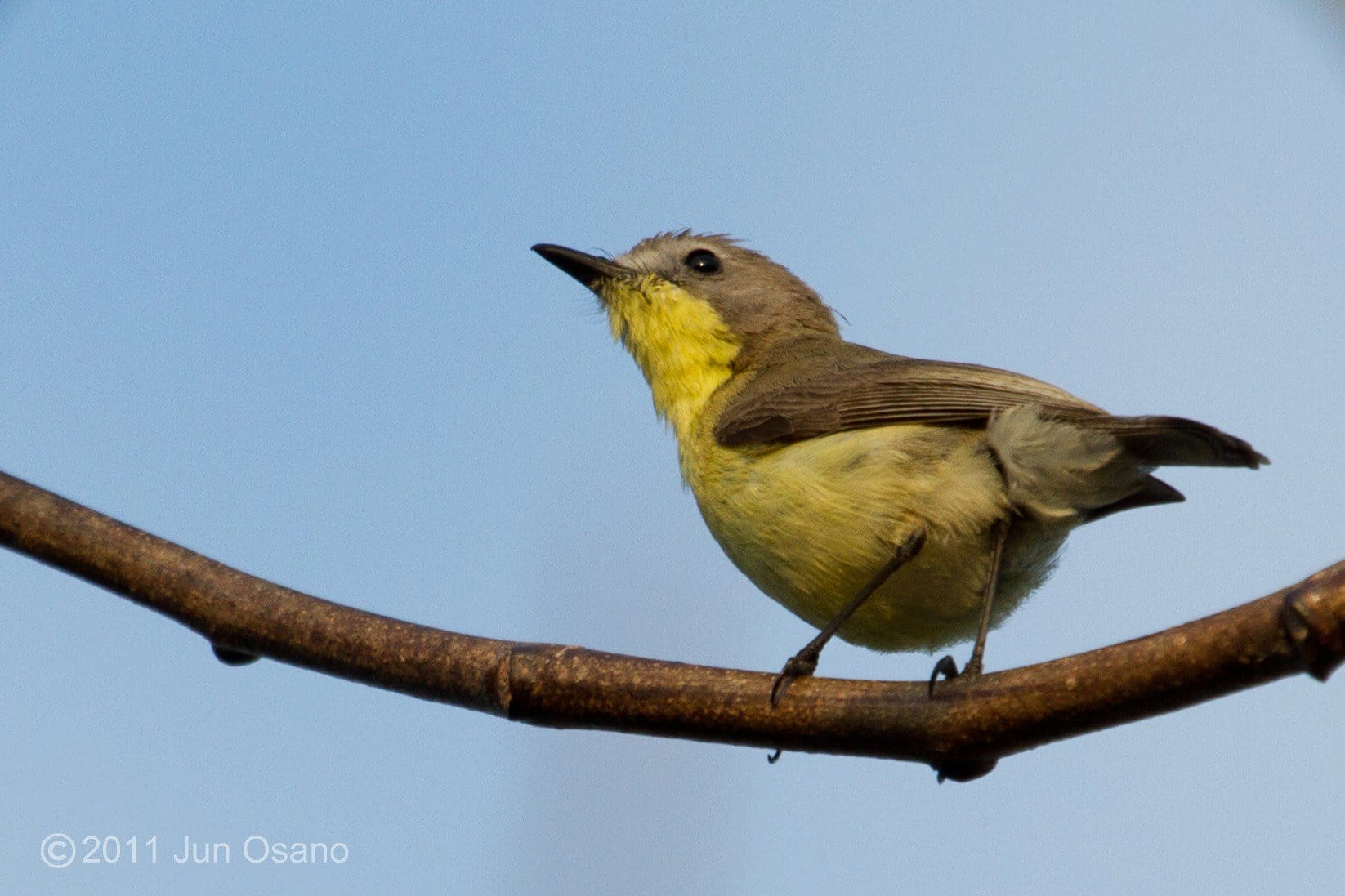
Bird Call: Here is a link to the call of the Golden-bellied Flyeater. Listen and check if you’ve been hearing it singing in your neighborhood.
8. WHITE-COLLARED KINGFISHER Halcyon chloris
Did you know there are blue-colored birds that can be found in the city? The White-collared Kingfisher is a blue and white bird and is the most common kingfisher that can be seen in urban areas. It has a dark blue, almost black, head and blue wings and back. Its underparts are white and it has a long, black beak. It calls with a noisy “ka-ka-kak ka-ka-kak” usually from high perches and eats a variety of food: from small fish, crabs, grasshoppers, and even lizards. When it hunts near water, it dives quickly snaring its prey with its long beak.
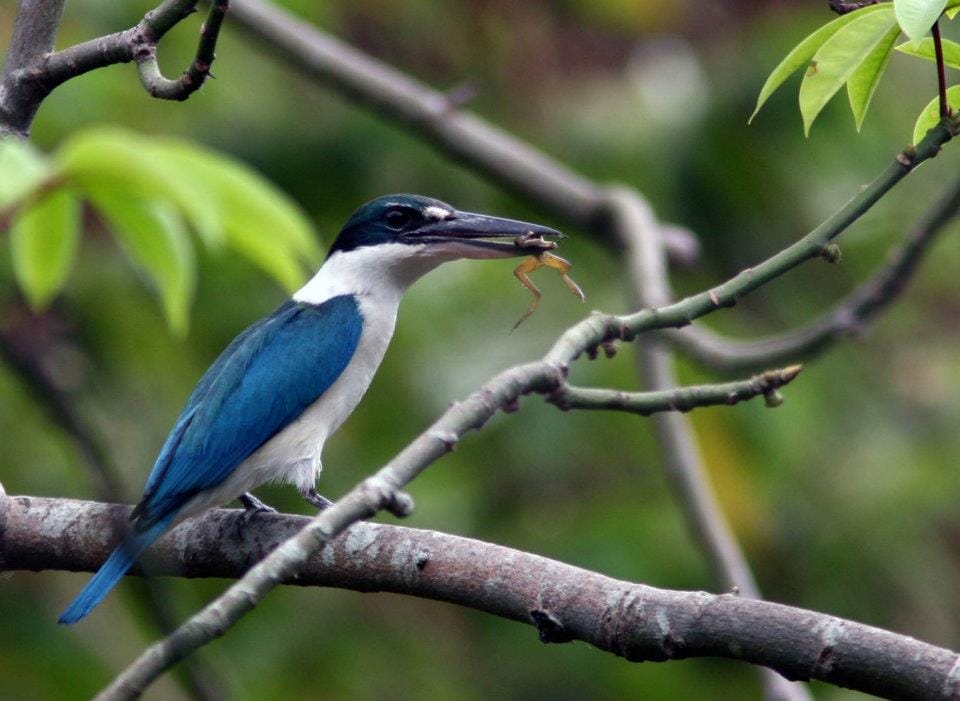
Fun Fact: Birds do love a bath especially in the summer! WBCP member Ixi shares her photos of a White-collared Kingfisher taking a dip in her pool!
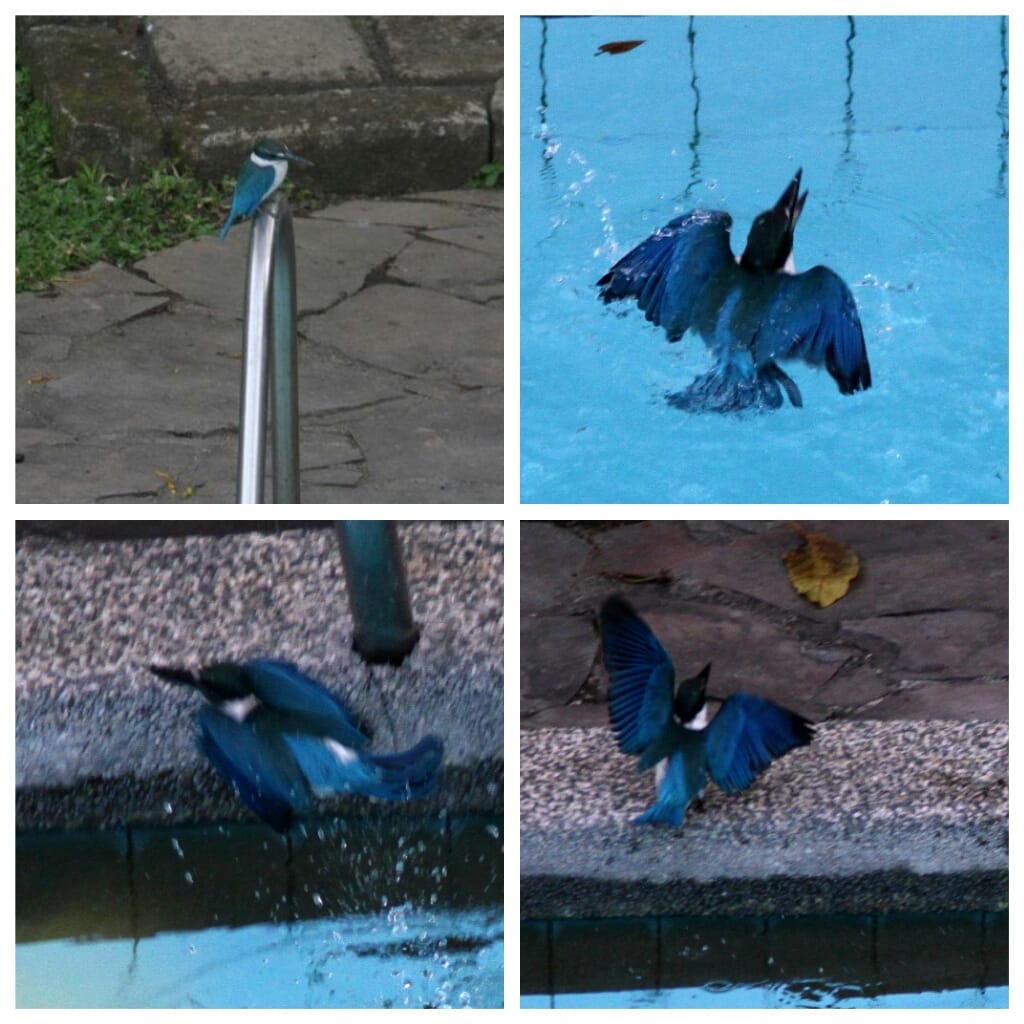
9. PHILIPPINE PYGMY WOODPECKER Dendrocopos maculatus
Yes! We do have woodpeckers in the Philippines and one species can be found in the city! The Philippine Pygmy Woodpecker is another bird that can be seen in urban areas. It creeps up and down and even around branches, pecking away at bark to either look for food or build a nest. Its call is a loud trilling sound, which has been described as sounding like a tiny machine gun.
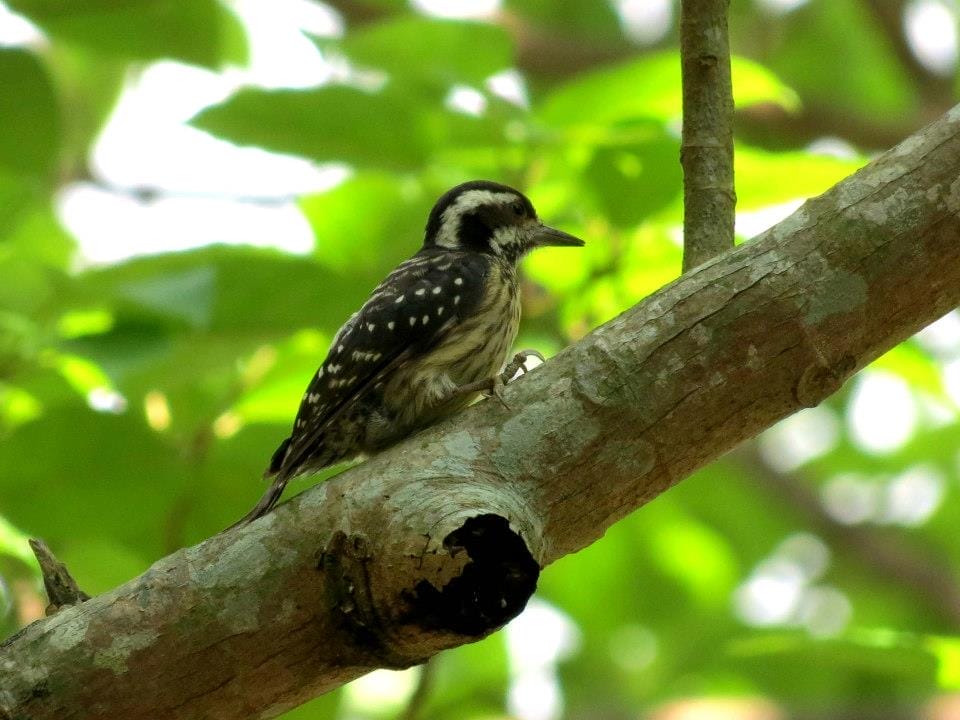
Fun Fact: Yes, Woody Woodpecker is based on a real woodpecker, reportedly a Pileated Woodpecker which is an American species. In the Philippines, we have similar-looking woodpeckers that can be found in our forests like this Greater Flameback. Awesome aren’t they?
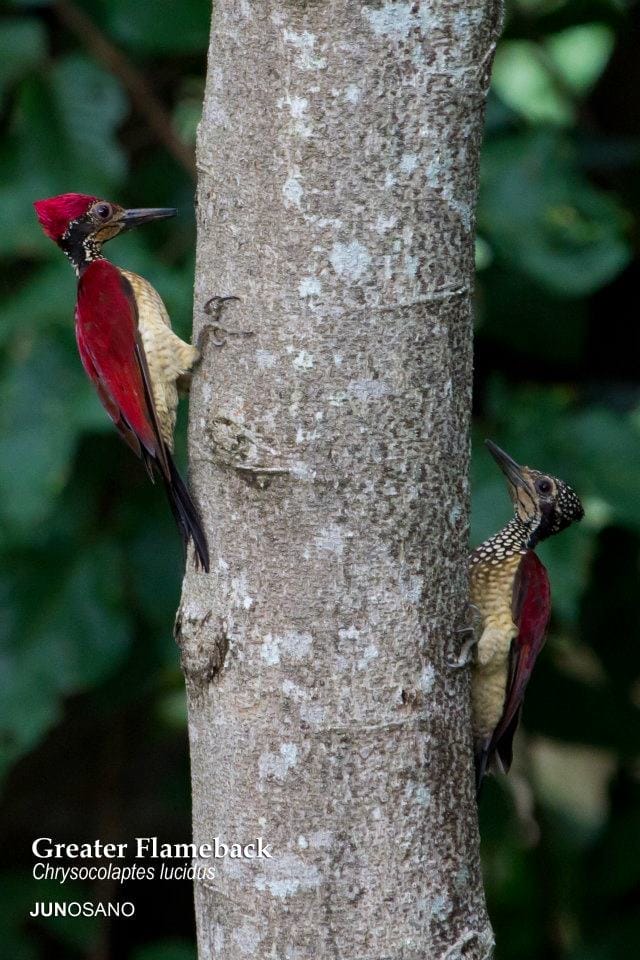
10. PACIFIC SWALLOW Hirundo tahitica
The tenth bird included in this list is the often unnoticed Pacific Swallow. These birds are seen either flying and gliding around or perched on electrical wires. Pacific Swallows have a moderately forked tail and reddish forehead, throat, and upper breast. The upper parts and wings are dark blue and the tail is black. These birds have adapted to urban areas and can be seen nesting in cup-like nests in the eaves of houses and buildings.
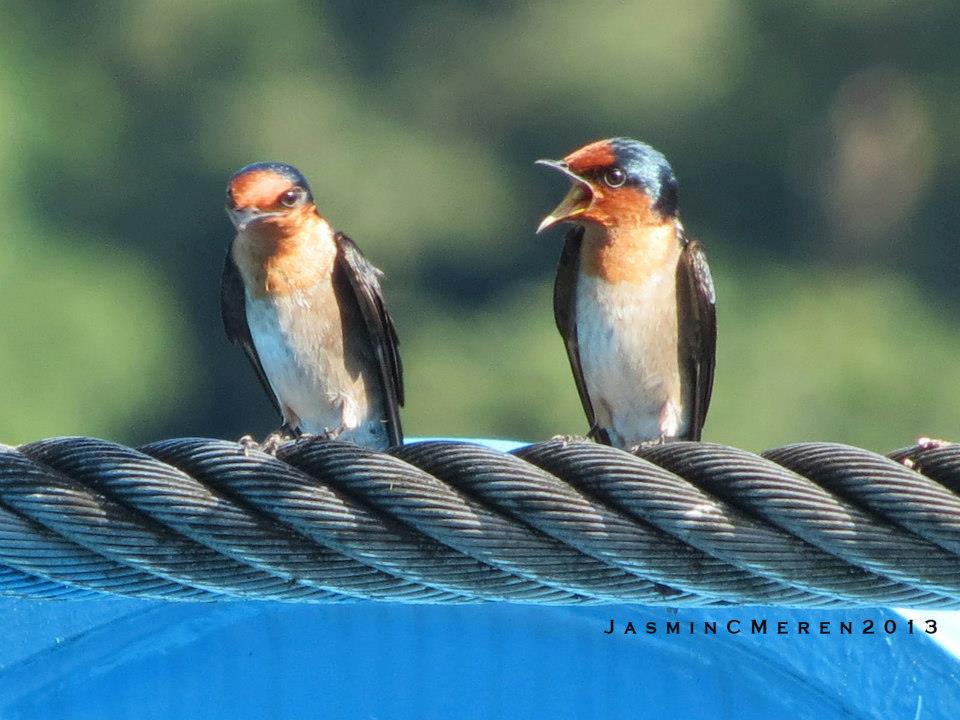
Fun Fact: An abundant migrant to the Philippines is the similar Barn Swallow. It can be told apart from the Pacific Swallow by long outer tail feathers and a black band across its chest. During migration season, watch out for swallows flying overhead and try to differentiate between Pacific and Barn Swallows.
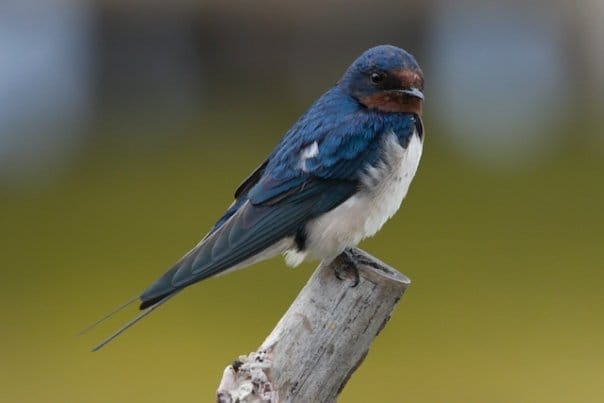
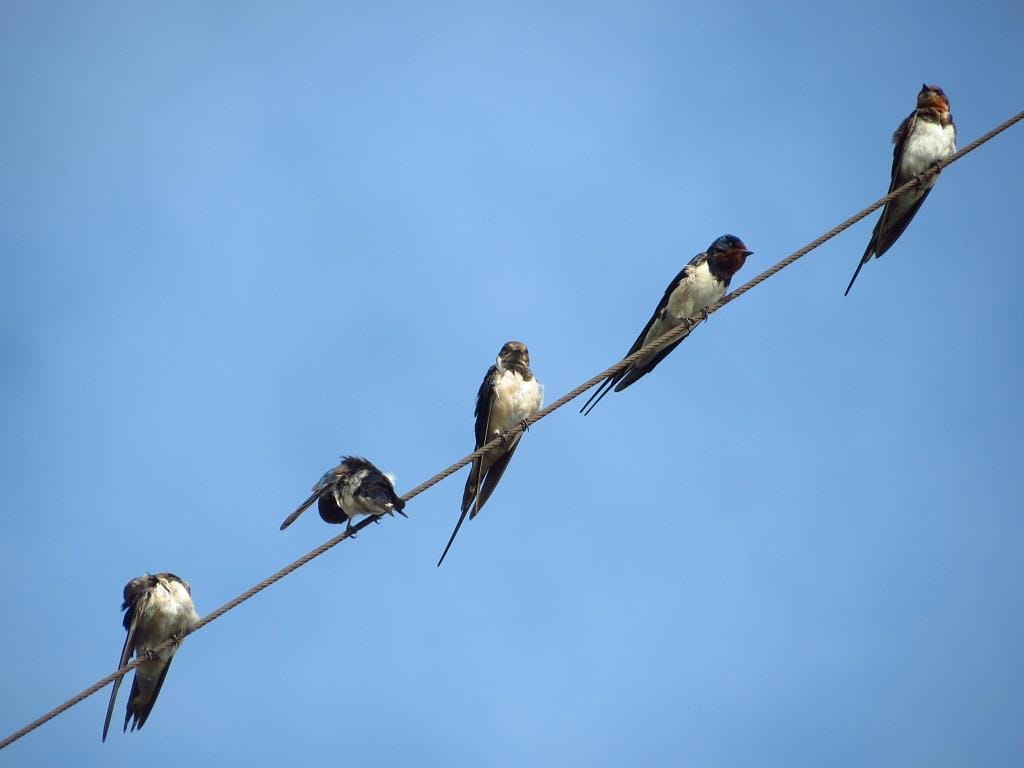
It was quite a challenge coming up with just ten urban birds! I asked some birder friends for their own list of the ten most common urban birds and their lists would usually vary with one or two species, depending where they are based. So, have you seen these birds in your area? What are your ten most common urban birds? Do share your list with us! Happy birding!

Pingback:July 2013 | e-BON
Nice to know trivias! 😀
Thanks for the comment JC! Keep on birding! – Maia
i love this article, maia 🙂 sharing it with my non-birder friends ;P i’ve seen all in this list, except the last one…well…i’m just not so sure…there are lots of swallows flying around in tagaytay, but i could never look at them long enough to scrutinize their details so i could id them 🙁 one of them has this yellowish/light brownish rump…will have to research harder…or hope to catch them perched 😛
Hi Eire! I’m sure by now you’ve probably seen all 10! The shape of the bird’s wings in flight is also helpful in ID-ing them. See you in the field soon! – Maia
Nice write up! When do we get to see the next batch of 10? 🙂
Thank you so much for these fun facts. Hope to see the colorful ones soon. I probably might seen barn swallows in Gensan airport terminal, the pied fantail in Tagbilaran city.
Thanks for your comment Donny! I hope you do get to see more birds in the future! Keep on birding! – Maia
Pingback:Birding in Quezon City | The Daily Heckler
Aside from the common mayang bato (eurasian sparrow), we often spot the maria cafra (fantail), bato-bato (zebra dove), and the switswit (sunbird) in our village in Quezon City. I had also seen the kakak (kingfisher) in a nearby golfcourse. Maybe other birds in this list too although I probably don’t recognze them from a distance, without binoculars. But what I really miss though is the oriole. We used to have a few nesting in our backyard when my family lived in Singapore and I remember it had a beautiful song. Btw, I was expecting that the pipit would be in this list and was surprised it wasn’t.
Hello Rocky! Thanks for sharing your own observations of the birds you see. The pipit is the Olive-backed Sunbird (which is also called switswit, tamsi, and chiwit in different localities in the Philippines.) Keep on birding! – Maia
Hi! Just want to add that siwit is a Waray term for sunbird. Tamsi is another waray word which in current usage is applied to birds in general… Nice article. I am also curious about tarat and martinez. Are these birds mentioned in the article?
Hi Eric! Thanks for reading the article and commenting =) The tarat is the Brown Shrike, a migratory bird, and the martinez usually refers to Mynas. In some parts of Quezon City, I’ve seen a number of Crested Mynas flying around =) Both the tarat and the martinez didn’t make it to the list though.
10 Birds I often see: Olive Backed Sunbirds (nesting in my garden), Golden Bellied Flyeater, Lowland white eye, Pied Fantail, Brown Shrike (all in my garden), Red Keeled Flowerpecker, White Collared Kingfisher, Pied Triller, Pygmy Woodpecker, Long Tailed Shrike, Copper Smith Barbet. I did not include Eurasian Tree Sparrow, Yellow Vented Bulbul and Zebra Dove. They are too commmon. 🙂
Nice Tita Lyds! =) – Maia
Songbirds in my backyard: pied fantail, magpie robin, YVB and another i have to see yet. The call sounds like a high-pitched and melodious “tagwa tiyot” repeated several times preceded by a down-scaling of the so-fa syllables.
Cool! Thanks for sharing your backyard birds list, Mike! I hope you get to see that mystery song bird of yours! – Maia
Oh! What a blessing! I finally identified my mystery songbird. It’s the Philippine Tailorbird. It has a wide repertoire of songs and calls that’s why I thought it was a different species. Mission accomplished!
I am an Australian Ornithologist (or bird watcher). I have been a member of several birding clubs in Australia since 1970 and published a lot of material here including my 130 page book “Canberra Birds: A Report on the first 21 years of the Garden Bird Survey” . On 17 August 2014 I will be arriving in Manila to stay until 3 September when I go to Singapore for 3 days before going back to home via Sydney. I have only been out of Australia once before (to China for nearly 4 weeks in 2009). I would like to come along to your group or any other related one if the dates and abilities match up. Either for a meeting or an outing.
Other than that the information my friend who I will be staying with in Marikina city most of the time has suggested she can take me to: Let’s go to Palawan or Boracay… Baguio.. Malabo zoo and Manila zoo And Montalban Zoo, Avilon zoo in Montalban rizal. Thee are just names to me so I do not know what is the best places.
Hello Philip! The places your friend mentioned are all zoos… might be a bit frustrating for a birdwatcher to see all birds in cages. You might want to check out the La Mesa Ecopark in Quezon City. Please email the WBCP officers for assistance. Maybe some members can take you out. You may find their email addresses on our website: http://www.birdwatch.ph. – Maia
Thanks for that. Yes we did go to zoos and yes of course it is better to see wild birds. The zoos there are a bit sad, with lots of overcrowding. Also very strange to see so many raptors in the zoos. They are not very good birds for captivity. Also I went with her to the La Mesa Ecopark in Quezon City on both of my visits in August 2014 and January 2015. I did see several birds there, though also missed a lot, that I could hear in the forest beside the main walkway. Maybe the best I thought that I did find there was a pair of Guaiabero. But then I have several species of parrots common around my home here almost every day.
Hello sir Philip Veerman! 🙂 I am Sheena, from University of Mindanao Digos Campus. And we’re currently having our research about bird diversity within areas of Digos City. So we will be identifying avian specias within the selected areas in the city. I would just like to inquire if we can get help from your expertise in identifying avian species? Thank you. GOD bless. 🙂
It is nice to get a reply. I have written several messages over a two years period and did not know if any of these messages got through. This is the first reply I have seen, although looking back I now see that there was an earlier reply to me. I have only been to Philippines two times for 3 weeks. So I am far from an expert in their birds to help locals with their identification. But then I am fairly good at it I guess and with a good book I could do most. From memory I found 9 of those ten listed plus a lot more around the city area. But I hope to go back there not too far in the future. It would be interesting to see University of Mindanao Digos Campus. As I wrote, I was responsible for a very large survey of urban birds in Canberra (Australia) and wrote the book about this. We have a vey big bird fauna here. As for Philippines it is interesting to see the strange name Maria Capra for the Pied Fantail. We have other species of fantail very similar to that in Australia so it was one of the easiest birds for me to find and identify in Philippines. It is to me like a very big Grey Fantail in black & white (Pied). I watched a pair building a nest in the park called Circle Park in front of Quezon city hall in urban Manila in January 2015. The book I have says they should not be nesting at that time of year but they certainly were, in this busy urban park.
Diba yung number 2 is also known as ibong tarat?
Hi Dave! The “ibong tarat” is actually the Brown Shrike, a migratory bird. They’re starting to arrive in the Philippines now that the migration season has started. – Maia
Love this!
Thanks for reading! Happy birding! – Maia
I have seen most of these except for 6, 7 & 9. And I can list the kapampangan names of some:
Eurasian Sparrow – Denas Bale
Chestnut Munia – Denas Paking
Yellow Vented Bulbul – Luklak
Pied Fantail – Silin-silinan
Olive-backed Sunbird – Pipit
Philippine Pygmy Woodpecker – Aluage
Swallow – Sibad
I forgot the kapampangan name for a kingfisher.
Wow! Thank you for sharing the Kapampangan names! My dad is from Tarlac =) Will ask him if he knows the name for the kingfisher =) – Maia
I wonder if it is confusing to call the Sunbird by the name “Pipit’. Because Pipit is also the English name for a quite different group of birds. (Genus Anthus).
Philip
Hi Philip! Local Filipino names of birds can be quite confusing. Aside from having different local names based on locality/province, some names are used in general for a number of species, like “tagak” is used for all kinds of egrets.
Great to find your site! :o) I sit in our family room (am in QC area) and wonder what all the bird calls are that I am hearing… Wish all the top10 birds had links for sounds; and also the common names .. How do I get them to come to our backyard so I can actually see (and not just hear) them? Thanks!
hi there! You can plant more fruiting and flowering plants in your backyard to attract more birds =) Best to plant native and endemic species to match the diet of the birds. Some plants they love are rambutan, guava, aratilis, and bignay! Good luck in making your backyard more bird-friendly! =)
Wow, thanks for sharing…
I have seen colasisis (wild not escapees) in the residential area of Cubao, of all places! Where I live in Marikina, I’ve heard colasisis, but not seen them yet. There are Java sparrows here, too, but they’re rare. Rarer still are the crested mynas, but they’re here all right.
Java sparrows used to be quite common. Often seen along with the ubiquitous Eurasians. It’s been awhile since i last saw one. Are they becoming endangered?
Hi Maia, i was catching up with a friend of mine the other day a non bird watcher and to him the idea of there being many different types of birds especially the small birds in his homestead was very amusing. He has always seen small birds around and assumed all of them to be one type. Being able to see the different species and to even document their stories is a unique gift. Be greatful, i am. @Kasun3i
Yes, it is a great thing to be able to see birds and document them! Happy birding! – Maia
Thank you for this! I saw a bird earlier attacking a cat and it is the first time I’ve seen such! (I am not a bird watcher, but am interested to be one). With your article, I know now that it is Maria Capra. 🙂
Thanks for sharing your exciting experience with the Maria Capra! Isn’t it fun watching birds in their natural and wild habitat? =) Hope you get to see more birds around you =) – Maia
I just learned from the recently concluded “Alternative National Seminar Conference on Environment, Health and History” that the bird with beautiful sound and attacks our neighborhood alley cats is called “Maria Capra”… Thanks to Prof. Juan Carlos T. Gonzales, PhD, Director, UPLB MNH who gave a lecture on “UPLB MNH: The University’s Natural History Museum for Tropical Biodiversity Research, Education and Conservation”.
Thanks for your additional information on the most common urban birds but I admit I am only familiar to at least 5 of them.
Hi Lorna! Thanks for sharing! I hope you can add to the 5 birds in your list =) Happy birding!
Lived in Leisure Farms a few years ago and we had an Oriole nesting in a coconut inside the crown of a tree. the bird was very distinguishable as it flew across the valley but once at its nest it “disappeared” . Their “Call” is easily mimicked and they will come to your garden with practice.
How nice to have nesting birds around you =) Thanks for sharing your story! Happy birding! =)
Thank you for your article. Helps me identify the birds in our subdivision (BF adjacent to Alabang Hills). I keep praying that the surrounding tall trees will remain standing despite the building frenzy in the area. The birds are such joy to watch and listen to.
That’s great! I’m glad the article helped you. I do hope the green spaces in your area are preserved so more birds can share the space =)
I’ve seen 8 out of 10 from your list. I haven’t seen the black naped orioles but not quite sure with the pacific swallow. I’ve got plenty aratilis trees and other fruit bearing trees in my backyard, and i’ve put a bowl of birdseeds underneath the trees. And a bird bath. They consume about 2 kilos per week if bird seeds. So you can only imagine the chirping sound i enjoy everyday. 😊
Hi Carmela! I hope your bird bath has been used by your neighborhood birds, especially in this heat! Happy birding!
Thank you for the article mam. Ive been reaserching for so long if what kind of bird is my bird-the one that ive been taking cared of for just two months coz unfortunately one of our cats got my bird biten and died and it gave me so much heartache until now.. By the way my bird is yvb(now i know)and i named his/her marfen coz i didnt know my birds gender. And for trivia mam my bird is so smart and sweet,marfen also knows how to take a bath herself,and he/she really treats me as her mother and used to follow me always thats way our cat got marfen caught. I just want to know more info about yvb,and share my experience with you all,.how i miss my yvb marfen..
Hi Rowena! Thanks for sharing your story. Birds such as the YVB is best kept in the wild =) I hope you continue to enjoy their presence by birdwatching and observing them in their natural habitat. Happy birding!
Thank you for putting this list together!
Thanks for reading it, Renan! Happy birding!
Hi Maia. I’ve seen all of them except the oriole BUT I hear it every day. Thanks to your article I know now that it’s an oriole. Hope you can feature more bird sounds. It helps esp that I can hear some birds but not see them. Very informative article I must say.
Hi Cora! Thanks for sharing your birding experience with us! And also for your feedback! I hope you’ve seen the oriole already! =) We’ll try to come up with a second part to the article and feature more birds soon! =)
Before, i thought that all ill ever see in the city are mayas and the common kalapati. Then one day looking at a small tree on a vacant lot from the window on our second floor i heard a bird that made a sound so different from maya, then i saw a dark brown bird with fan-like tail. Searched it and realized it was the fan tailed bulbul or maria capra. So far those are all the birds ive ever seen in the city
Hi Dexter! Thanks for sharing your Maria Capra sighting with us! The thrill of seeing a new bird is always a great thing to hear about! I hope you see more birds in the city! As long as we have green spaces, the birds will stay and thrive =)
Thanks for this interesting info. We have several birds in our big garden here in Sta. Ana, and I always wanted to know which bird it is that tries so hard to make the nicest sounds of all. It turned out to be the Golden Bellied Flyeater. Very cute.
Best wishes.
Hello Casey! Thanks for reading and for sharing your story! The Golden-bellied Flyeater really has a pretty song =) I’m happy the article helped you identify it! Happy birding!
I like your website. I have seen all 10 birds on your list in Butuan City, except the Oriole. I may replace it instead with the Asian Glossy Starling locally called “lansiang”. They abound in our place that people use small firecrackers to drive them away from subdivisions as they get loud and noisy, especially when they roost. I feel sorry for them, but they seem to love to live where people dwell.
Hello Joe! Thanks for dropping by and sharing your story! I hope you’ve seen the oriole already =) The lansiang can be quite rowdy especially in large groups! They are nicely colored birds though with their glossy feathers and red eyes! Happy birding!
Hello! I’m sheena. I am from University of Mindanao Digos Campus. The article was really a big help, most especially because, birds will be our central focus in our thesis. We will be dealing with Urban birds, because our study is Urban bird diversity as an indicator of urban development. We will still be dealing with birds in the rural area though. But our main concern are the birds commonly found in urban areas. So thank you for this article and please, if it’s you’re great intention to help, we would be very glad to accept facts and ideas with regards to avian species. Thank you po. GOD bless. 🙂
Hello Sheen! Thanks for the feedback! Let me know how we can help you more. You may send an email to teachermaia@gmail.com or visit the Wild Bird Club of the Philippines website at http://birdwatch.ph/ for more information.
Hello Sheena,
I wonder how your study is going. I now see we wrote some correspondence via this service in 2015. I wrote a book “Canberra Birds: A Report on the first 21 years of the Garden Bird Survey”. This is a detailed analysis of the Garden Bird Survey that has been run by Canberra Ornithologists Group in Canberra, the Australian capital city, since July 1981. The report covers a lot of information on the subjects you mention. Although obviously the birds and the situation are very different between the two places. Maybe I can help with some ideas for you.
What is useful now is that I am planning my third trip to Philippines, in April 2018 and would like to visit Davao. I would like to see the Philippine Eagle Centre and some natural areas there. I am guessing, after a look at a map that these are not too far apart. Can we do something with this? I will be travelling with my wife who is from Manila and speaks fluent Tagalog, if that helps. Though your English writing is good.
Philip
Thanks so much for this list and providing sound links to the different bird calls! I have always wanted to know what bird made that sound I used to hear as a child in my lola’s mango farm that I also hear in UP Diliman. The bird with blue wings I see in the fields is also now de-mystified. Really helpful!
Hello Louella! Thanks for reading and sharing your story with us! I hope you get to see more birds! Happy birding!
On the times I was there (August 2014) and moreso January 2015, in Manila and January 2015 also included Palawan, I think the most Common Urban Birds were the swifts or swiftlets. Obviously not in gardens but lots flying over. I tried pretty hard to work out what they were. Probably several species……..
Common Birds in our Area are from 1 to 5. here in quezon city novaliches 😀
Thank you for this list, Maia! I especially loved the bird sound recordings! I live in Taytay, Rizal. Last year I often watched a pair of YVBs in the tree outside my kitchen while I washed dishes. Now it’s fantails that are often in the tree. I love them too but I wonder what happened to the YVBs. I’ve seen golden bellied flyeaters and Pacific swallows here too. Some of the rest of the rest I’ve seen elsewhere — the sunbird in my parents’ home in Palauig, Zambales; the kingfisher in Coron, Palawan; the bato-bato in Jala-jala, Rizal. I’ve never seen a woodpecker but I was pleasantly surprised to hear the sound it makes in Malungon, Sarangani.
Thank you for this article.
I live in Lucena City suburb. uwak (crow) and tagak is common here. Layang-layang (swallow) is abundant in downtown.
Thanks for this very informative and fun write up. Keep up the good work
So is the sunbird – we call it tamsi in the Visayas – a hummingbird ? I saw a small pure red one in Valencia, Neg. Or. , very cute n lovely
No the sunbird is not a hummingbird. Because sunbirds feed on nectar and are small they can resemble what some may think hummingbirds look like. But hummingbirds are a completely different group with a very special way of flying and feeding and they only occur in the Americas.
I think, you saw a crimson sunbird. Congrats! Sunbirds are our answer to the hummingbirds of the Americas. Small, colorful flying jewels.
There is a common bird in our backyard I cannot ID. It is very similar in size to the Eurasian Tree Sparrow, it is also colored brown but lacks the black spot on the cheek.
My backyard is always bursting with bird songs especially in the early mornings. There is one song bird I’m very much curious about and which I have yet to see. I suspect it is a “thrush” specie because of the loud and melodious call. I often hear it from among the trees quite distant from my location like parks and playing fields. At first, I thought it is the flyeater but the song is more ostentatious. The YVB and fantail songs are a bit more modest. This one, it seems, knows it is a singing champion. Even the ivory backed sunbird is outclassed by this bird’s vocal chops. The tailor bird is flat and monotone and the shrike sounds like an intermittent snare drum. This one for me, is the lead vocalist among the local talents, but sadly, i have yet to set my eyes on it. Any suggestions for a good, affordable binoculars for the mission?
Somebody on FB posted a european nightingale singing..I thought, “I hear that song every morning…how is that possible?” Now I see that the most common bird in my San Juan backyard is the Yellow-vented Bulbul also called a nightingale. I also identified a new flock of birds that just arrived in the neighbourhood..the Black-naped Oriole. The sound bite and video confirmed my guess. If I can capture the song of the bulbul I will post it here. I see a seasonal bird here, very black head and back with white wing stripe and grey white belly.. It sticks close to the ground, its tail is always erect it and nests in the gumamela bush I believe. It could be the pied fantail and I just have not seen the eyebrows but I don’t think so. What a pleasure to find this great blog! Thank you so much!
My guess is an oriental magpie robin. I had a couple of them hang out in my backyard last year. Amazing song birds!
In the southern part of Negros Oriental, in addition to the list of most common urban birds we have the glossy starling “galansiang” and the brown shrike “tibalas” that can easily be seen around. In earlier years, the white-collard kingfisker “tikarol” was common, but now are quite hard to find. The black-naped oriole are also hard to find these days, but used to commonly hear their calls years ago.
Great article! I’ve been fascinated by the growing variety of bird species in the urban areas of Metro Manila. I have personally seen the following:
Pied Fantail – on our street in Mandaluyong
Zebra Dove – also on our street in Mandaliyong
White Collared Kingfisher – inside the NCMH compund (Mental Hospital) also in Mandaluyong and also in CCP complex near Folk Arts Theater.
I’ve also seen other birds not in the list:
Barred Rail – inside the NCMH compound.
Terns and snipes – along Pasig River
Asian Glossy Starlings – I’ve been seeing a lot of them sitting on the electric post in front of my house
And I may be wrong but I think I saw a magpie attacking a dog while I was biking around Mandaluyong.
My sister said she saw a Sunbird in her house in Merville Paranaque. She thought it was a hummingbird.
Looking forward to other articles like this. Cheers!
do you know any types of trees that are attractive to birds? a caimito or star apple for one came to my attention at twilight was filled birds.
Where are these common bulbuls. No orioles, yet,either. We’ve been in Liloan Cebu for six months and havent seen one yet. Most common are maia, starling, munia, sunbirfd. Also frequent fantails, pacific swallow, both shrikes. Heard daily are zebra doves but haven’t seen one yet.
Hi! may I know the local name of White collared kingfisher and Golden Bellied Flyeater? thanks
Thank you
In our local “Hiligaynon” dialect, the kingfisher is called “Salaksakan.”
Thank you. how about the golden bellied flyeater? do you have any idea? 🙂
Here is out neighborhood bird list from Liloan, Cebu.
Bee-eater Blue-tailed — unconfirmed
Bulbul Yellow vented — unconfirmed
Dollarbird – several times
Dove Zebra — heard daily, rarely seen
Dove Rock — domestic, flock seen often
Egret, Little (?) — occasional flyover
Fantail Pied– daily
Flowerpeciker Red-striped — daily
Kingfisher, Collared and Common — both common in nearby wetland
Magpie-robin Philippine — unconfirmed
Munia Chestnut — daily
Oriole Black-naped — unconfirmed
Rock-thrush, Blue — unconfirmed
Shrike Brown — daily
Shrike Long-tailed — one individual, always there
Sparrow Eurasian trtee — abundant everywhere
Starling Asian glossy — abundant everywhere
Sunbird Olive-backed — common, many daily
Swallow — Pacific and Barn — daily, hard to distinguish. Striated (?), too.
Triller Pied — occasional
Woodpecker, Philippine — one seen
Woodpecker, White-bellied — one heard calling
Why does no one mention the swifts? When I was in Manila in October 2014 and January 2015 and even moreso in Palawan in January 2015, there was constantly swifts and swiftlets flying over. As a visitor to Philippines I found them hard to identify but there sure were a many of them. I will be back there in April and wish I knew how to get an answer from you as to how I could arrange to attend if you have any events on in April.
I’ve been constantly alert for swifts in the skies here in Cebu, but have not yet seen one.
Thanks for the answer. I have not been to Cebu. Possibly will go in April.
Someone messaged me about the golden-bellied flyeater (now renamed gerygone), No, I’ve been listening for their loud conspicuous song, but no luck. Also have not found another migrant, blue rock thrush, which should be here. Going to Oslob next weeek, looking forward to migrant shorebirds.
I encountered the golden-bellied flyeater (now renamed gerygone) at various places around Manila, in the university grounds, the gardens around the Aquino zoo (near where the Philippine Eagle is housed), the Circle Park I think in Quezon city, at eco park, etc. Maybe because their call is similar to some of the Australian gerygone species, I was able to locate them. Although not exactly easy to watch, as they are small and spend most time being active high in the trees. Another interesting thing was finding a pair of Pied Fantails on a nest at Circle Park in Quezon city in January 2015. According to the book I have they should not be nesting then. The park was very busy with people. As for migrant shorebirds: On 2 Feb 2015 I eventually go onto a good wader site near Manila, though it was a difficult trip to get to the place – known as Candaba marsh, but have no idea if I actually got to the best location. I am not completely sure of all species and no doubt missed several but the ones I’m fairly or fully confident of were 100 or more Wood Sandpipers, then in lesser numbers, Common Redshank, Common Greenshank, Little Ringed Plover, Golden Plover, Common Sandpiper, Greater Sand Plover and / or Lesser Sand Plover, Ruddy Turnstone, Grey-tailed Tattler, White-winged Black Tern, Oriental Pratincole, Purple Heron, ………
Thanks. Winter shorebirds are very difficult, except the obvious ones. We dont have a car, so we’ll just have to check out the beaches we can get to. Dont have a scope either, just hand-held binocs.
A plague of bulbuls! After going six months without ever seeing a bulbul, we went to a park (suburban Cebu) yesterday, and saw several Yellow-vented, posing beautifully for us. (also a dozen Richard’s Pipits.) Then this morning, in trees from our veranda, several more bulbuls. But wait. Then took a birdwalk around our complex, and saw several Philippine bulbuls. Plus a White-eared dove, which I had heard once before, but never saw.
Went to Oslob, found nice quiet bird walk. Coucal, Coppersmith, Pied Bushchat, Oriole, and the common things. Perfect zero on the beach at low tide, and not even a gull at the ferry landings to Dumaguete and back.
Could you do a top 20, please? I love your fun facts.
Thank you, Myra! What a great idea! Will come up with another feature soon! =)
Here where I live in a suburb of Cebu, Im doubt if there are 20 species that would likely be encountered. Here are the most common I’ve found, in order of abundance.:
Glossy Starling
Eurasian Tree Sparrow
Olive-backed Sunbird
Chestnut Munia
Pacific Swallow
Red-striped Flowerpecker
Brown Shrike
Barn Swallow
Zebra Dove
Pied Fantail
Yellow-vented Bulbul
Philippline Bulbul
Long-tailed Shrike
Pied Triller
A few other species, seen only once or twice, so may or may not be expected. Other species we’ve seen in open country, have not appeared here in our suburbs. They include Oriole, Coppersmith, Brahminy Kite, Coucal, Pied Bushchat, Richard’s Pipit, Dollarbird
There is an estuarial wetland with easy access near my houses where we see Common and Collared Kingfisher,Whiskered Tern, Common Sandpiper, Moorhen, Waterhen, Black-headed Gull and Egrets.
That’s a very nice list! Thanks for sharing, Jim! Happy birding! =)
I am visiting Philippines now for the third time (from Australia). I actually find it so much harder to find birds here, compared to Australia (apart from Tree Sparrows, Y-v Bulbuls and swallows). Two particular questions: At John Hay park in Baguio I saw a flock of flying Accipiters. About 10 birds, flying together in quite high circles but soon vanished from view. Quite pale underneath with dark edge to tail and wings, only slight sign of barring. In Australia we never see flocks of Goshawks or Sparrowhawks, they are completely solitary, except when nesting. My book suggests most likely species is Chinese Goshawk. Any suggestions? Also yesterday we did a cruise of some of the islands at 100 Island park. From the boat I quickly saw 1 bird fly onto trees on an island. Very bright shiny blue across the back and otherwise mostly black. From the book I thought Asian Fairy-Bluebird from my quick distant view of the blue parts. But book says only in Palawan. The Philippines Fairy Bluebird should occur there. Any suggestions?
Thanks to Kristen’s post of a year ago,I was able to immediately recognize my first singing YVBulbul. I heard it at 3 am, and remembered seeing that comparison to the nightengale. We hear them calling in our garden trees every day, but this is the first I heard singin
Another exciting report — my neighbor saw an Eastern Grass Owl behind his house last week. I’ll be watching attentively for that one.
Thanks for the knowledge, I was interesting and helpful.
I started getting interested with birdwatching in 2014 and these are among the birds species I have seen when I started here in Los Banos, Laguna. Yellow-Vented Bulbul is my spark bird! It is commonly feeding on the fruits of vines on our fence.
My interest in birdwatching was enhanced further after having a basic photography workshop in our office, ASEAN Centre for Biodiversity. I was assigned with a camera in our office, with the feature of high zoom in capability. These city birds(in my case, lowland birds) are my first targets then (2014), then I got to learn more about the other species that can be seen here in UPLB, particularly in the Molawin creek and the higher elevations of Mt. Makiling. 🙂
Quite a few YVBs and zebra doves have made the tree behind my house their home so…. happy me! I find the sound made by the zebra dove comforting.
For the past three days I’ve seen a grey wagtail out there too. A lifer for me.
Heard for about two weeks now but not yet seen. song goes like this : chup chup chup tititititit hoooo weeee! Variations on those syllables too. Has anyone else heard this bird song?
I’ve been looking for an article like this so I would know these birds all over my small place we call “Forest in the City” 🧐 They’re my stress reliever … alarm clock… thank you 💕🙏😷
Nice write up and am now able to put a name to those birds I normally see. So when will the write up of the next batch of birds be ready? 🙂
I read your article and liked it very much. Thank you for writing an excellent article.
#etrabet
https://etrabetgiris.info
very successful content and communication
That shows you have an insight to get great information.
thank you very post bro.
Pingback:5 Most Common Urban Migratory Birds in the Philippines – Wild Bird Club of the Philippines
Pingback:WBCP Coloring Pages: Collared Kingfisher and Olive-backed Sunbird – Wild Bird Club of the Philippines
Pingback:Nature Study Philippines: Birds – Bring Out Brilliance
My ex husband is a bird watcher so I know most of this common birds and saw them in my yard here in Siargao. Just then I saw wag tail and a group of swift in the electrical wire. I’m not quite sure if Maya here is the same as house Sparrow in Africa and England.